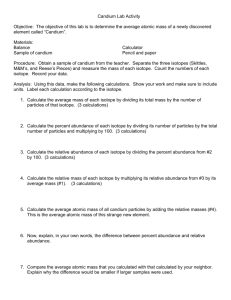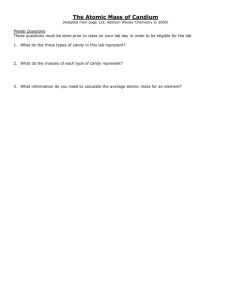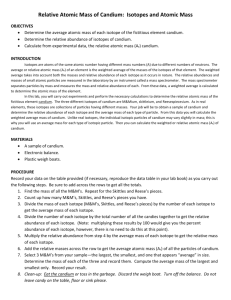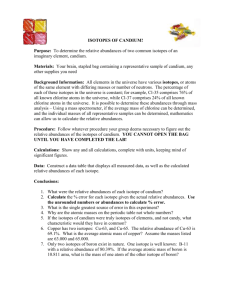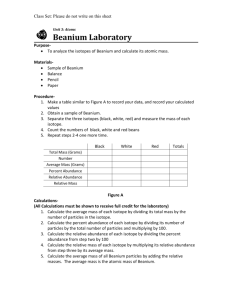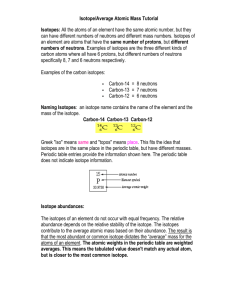Atomic Mass Candium Lab
advertisement
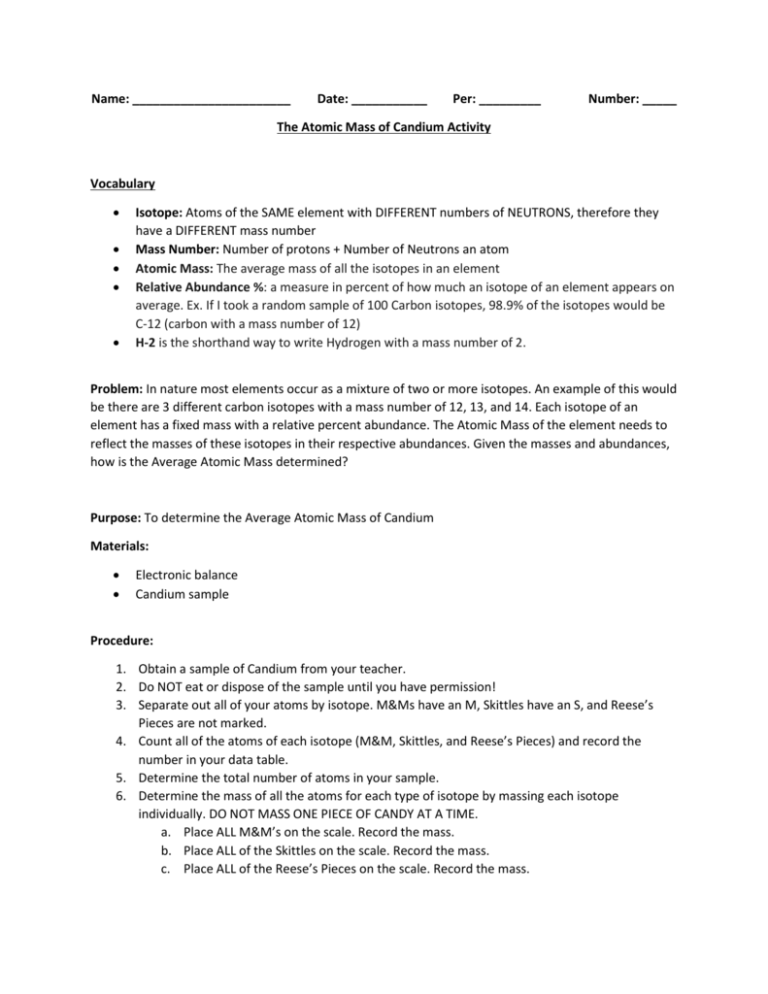
Name: _______________________ Date: ___________ Per: _________ Number: _____ The Atomic Mass of Candium Activity Vocabulary Isotope: Atoms of the SAME element with DIFFERENT numbers of NEUTRONS, therefore they have a DIFFERENT mass number Mass Number: Number of protons + Number of Neutrons an atom Atomic Mass: The average mass of all the isotopes in an element Relative Abundance %: a measure in percent of how much an isotope of an element appears on average. Ex. If I took a random sample of 100 Carbon isotopes, 98.9% of the isotopes would be C-12 (carbon with a mass number of 12) H-2 is the shorthand way to write Hydrogen with a mass number of 2. Problem: In nature most elements occur as a mixture of two or more isotopes. An example of this would be there are 3 different carbon isotopes with a mass number of 12, 13, and 14. Each isotope of an element has a fixed mass with a relative percent abundance. The Atomic Mass of the element needs to reflect the masses of these isotopes in their respective abundances. Given the masses and abundances, how is the Average Atomic Mass determined? Purpose: To determine the Average Atomic Mass of Candium Materials: Electronic balance Candium sample Procedure: 1. Obtain a sample of Candium from your teacher. 2. Do NOT eat or dispose of the sample until you have permission! 3. Separate out all of your atoms by isotope. M&Ms have an M, Skittles have an S, and Reese’s Pieces are not marked. 4. Count all of the atoms of each isotope (M&M, Skittles, and Reese’s Pieces) and record the number in your data table. 5. Determine the total number of atoms in your sample. 6. Determine the mass of all the atoms for each type of isotope by massing each isotope individually. DO NOT MASS ONE PIECE OF CANDY AT A TIME. a. Place ALL M&M’s on the scale. Record the mass. b. Place ALL of the Skittles on the scale. Record the mass. c. Place ALL of the Reese’s Pieces on the scale. Record the mass. Data Table: Candium Data Skittles M&M’s Reese’s Pieces Total Number of Atoms Total Mass of Atoms Average Mass of One Atom Relative Abundance (%) Relative Mass Atomic Mass of Candium Total 100% Calculations and Data Analysis: Show all work and copy answers to data table. 1. Calculate the average mass of one atom for each isotope. Average Mass of One Atom = (Total Mass of Each Isotope) / (Total Number of Each Isotope) Average Mass of M&M’s = Average Mass of Skittle = Average Mass of Reese’s Pieces = Write your answers in your data table. 2. Calculate the relative abundance % of each isotope. Relative Abundance % = [(Total Number of Atoms from the isotope) / (Total Number of Atoms in Candium)] Relative Abundance % M&M’s = Relative Abundance % Skittles = Relative Abundance % Reese’s Pieces= Write your answers in your data table. 3. Calculate the Relative Mass of each isotope. First convert Relative Abundance % into a decimal. Ex: 59% = 0.59 Relative Mass = (Relative Abundance in Decimal Form) x (Average Mass) Relative Mass of M&M’s = Relative Mass of Skittles= Relative Mass of Reese’s Pieces= Write your answers in your data table. 4. Calculate the Atomic Mass of Candium: Atomic Mass of Candium= (Relative Mass M&M) + (Relative Mass Skittles) + (Relative Mass Reeses Pieces) Atomic Mass of Candium= Write your answers in your data table. Conclusions, Questions, and Application: (Full Sentences, may write on separate paper) 1. Explain the difference between the percent abundance and relative abundance. What is the result when you total the individual percent abundances? The individual abundances? 2. The percent abundance of each kind of candy tells you how many of each kind of candy there are in every 100 particles. What does relative abundance tell you? 3. Why are Atomic Masses on the periodic table not whole numbers? 4. How are the following isotopes of hydrogen alike? How are they different? a. H-1 b. H-2 c. H-3 5. The four isotopes of lead and its abundances are: Pb-204, 1.37%; Pb-206, 26.26%; Pb-207, 20.82%; and Pb-208, 51.55%. Calculate lead’s approximate atomic mass.

